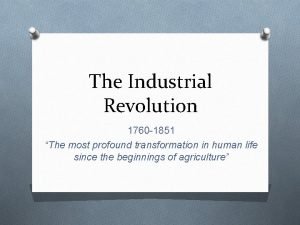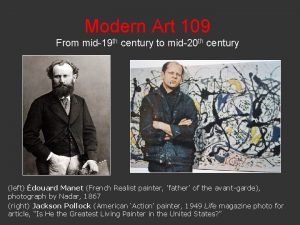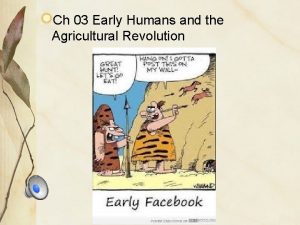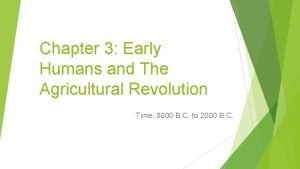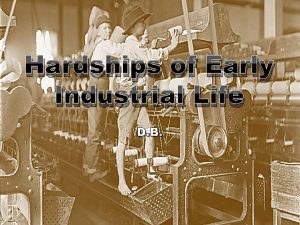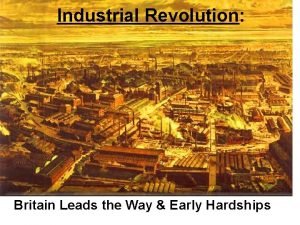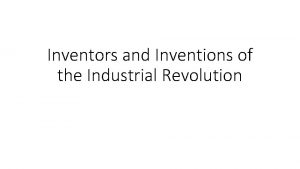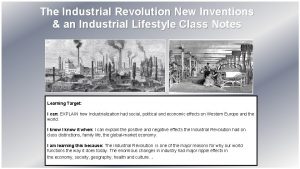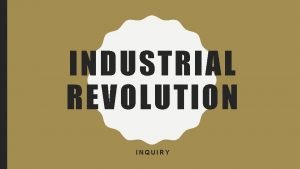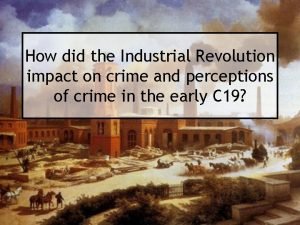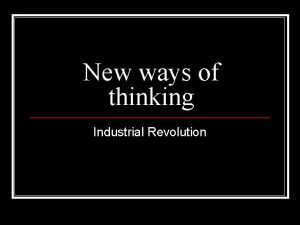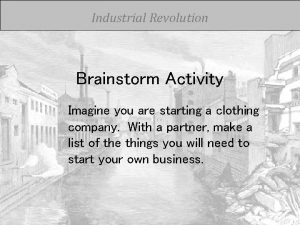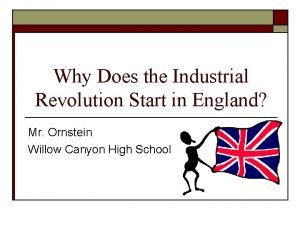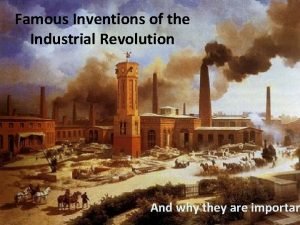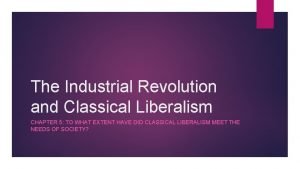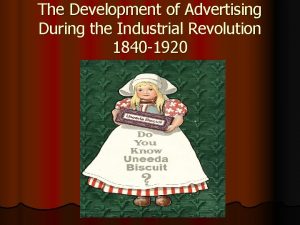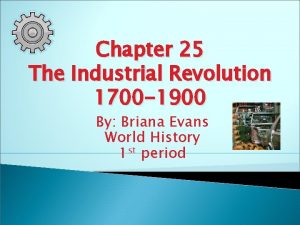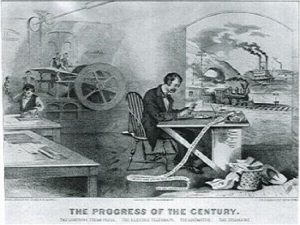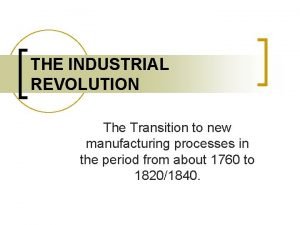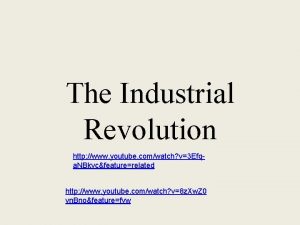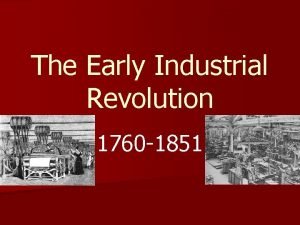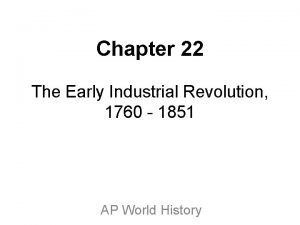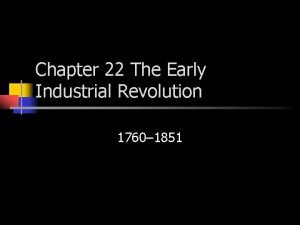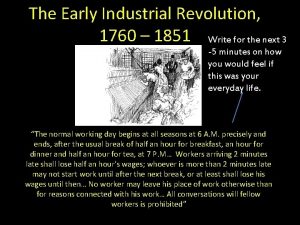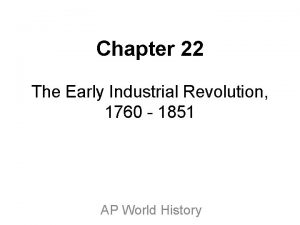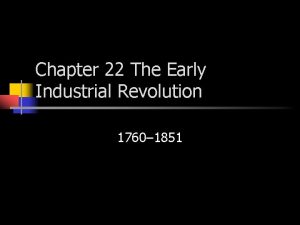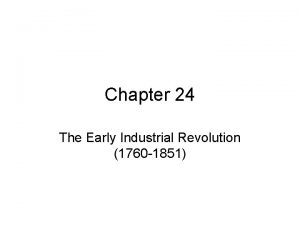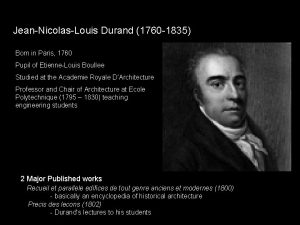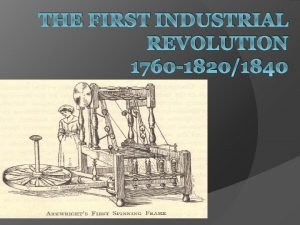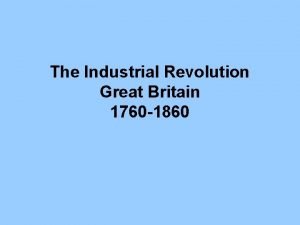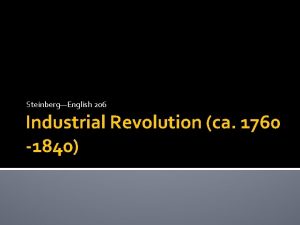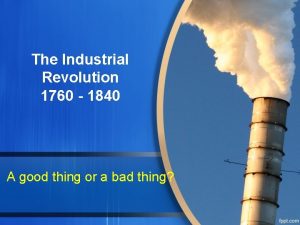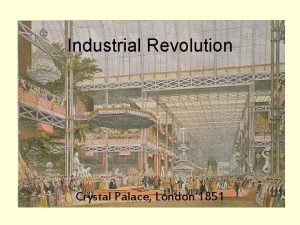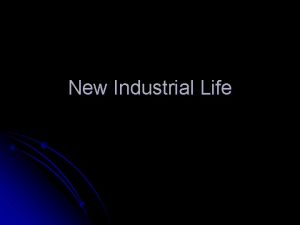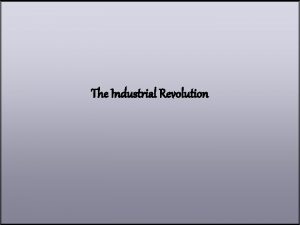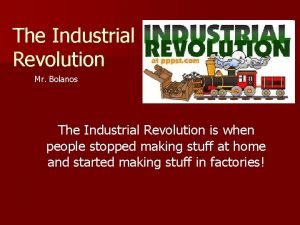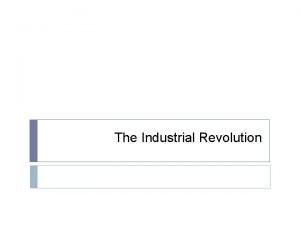Ch 22 The early Industrial Revolution 1760 1851



























- Slides: 27

Ch. 22 The early Industrial Revolution, 1760 -1851 (Part 1)

Questions • 1. What was the Industrial Revolution & what were its main features? • 2. What were the causes of the Industrial Revolution? • 3. What country was the first to experience the Industrial Revolution?

Industrial Revolution • the transformation of the economy, environment and living conditions that resulted from the use of steam engines, the mechanization of manufacturing in factories and innovations in transportation and communications. • it happened first in 18 th century England.

Why the Industrial Revolution happened first in Europe (England)?


Europe-England • Europ. rulers-alliance with merchant classes. • Europe-at the center of the most varied exchange. • England 1) Enclosure movement-ind. workers with few options 2) Market prod. 3) British commerce-worldwide

Causes of the I. R. • 1. China & the Islamic world stagnated by the early modern era. • population growth( more food, resistance to diseases, high no. of birthrates). • 2. the agricultural revolution( new crops, changes in farming methods, landowners fenced off their lands-Seclusion Act). • 3. trade & inventiveness.

Britain • Resources: coal, iron ore • Polit. Factors 1)Tariffs to protect businessmen 2)Unified internal market 3 )more power for the royal enterprises

The technological revolution What was the mass production and mechanization?

The technological revolution • Developments in railroad system, mining, manufacturing & services. 1. Mass-production: the manufacture of identical products by the division of labor into small, repetitive tasks. ( J. Wedgwood, pottery) 2. Mechanization-the cotton industry.

Spinning wheel/The spinning jenny, 1764

The water frame (power loom), 1769

Mule, 1785

Cotton factory

What were the consequences of mechanization? What was the most important innovation of the Industrial Revolution? Why?

The technological revolution 3. The iron industryinterchangeable parts 4. the steam engine- 1769, J. Watt 5. railroads: the locomotive. G. Stephenson( 19 th century)

• 6. electric telegraph, Morse ( 1837)


What was the impact of the Industrial Revolution on aristocracy, middle class people, rural life & working conditions?

Impact on social classes • • Aristocracy-little material loss Middle class: most gains M-class women: wives, mothers, homemakers. Beneficiary: the middle class Standards of living didn’t improve until 1850 Increased disparities in income Impact on the economic & political ideas.

The impact of the Industrial Revolution 1. Industrial cities-growth, unhygienic conditions. epidemics, overcrowded 2. Rural environmentdeforestation, transportation changed the rural life.

The impact of the Industrial Revolution • • • 3. Working conditions Most jobs: unskilled, repetitive, low paid. Separation work/home Women & kids had to work Preference for children 'labor” Long hours, low wages, child labor.

The impact of the I. R. • Increased demand of sugar, coffee, cottonprolong slavery in U. S.

What was the impact of I. R. on society? Who were the real beneficiaries of the Industrial Revolution?

New economic & political ideas 1. A. Smith “laissez faire”(government should not interfere in business) 2. Bentham-the state should take action to manage the economy.

New economic & political ideas • 3. utopian socialists: C. Fourier -ideal society without capitalists. • 4. positivism-social & economic problems could be solved by applying scientific methods; this will lead to continuous progress. • 5. Malthus& Ricardo-poverty is the consequence of overpopulation; should be addressed by delayed marriage& sexual restraint.

Industrial & nonindustrial worlds • World divided: industrial & nonindustrial • Nonindustrial countries: sources of raw materials & markets for industrial countries. ( this will lead to imperialism).
 Eli whitney cotton gin
Eli whitney cotton gin Mid19
Mid19 Early cpr and early defibrillation can: *
Early cpr and early defibrillation can: * Early humans and the agricultural revolution answer key
Early humans and the agricultural revolution answer key Chapter 3 early humans and the agricultural revolution
Chapter 3 early humans and the agricultural revolution Russian revolution vs french revolution
Russian revolution vs french revolution Economic causes of french revolution
Economic causes of french revolution Third agricultural revolution definition
Third agricultural revolution definition Hardships of early industrial life
Hardships of early industrial life Hardships of early industrial life
Hardships of early industrial life Key inventions of the industrial revolution
Key inventions of the industrial revolution Negative effects of the industrial revolution
Negative effects of the industrial revolution Syncretism definition ap human geography
Syncretism definition ap human geography The tyger industrial revolution
The tyger industrial revolution Industrial revolution inquiry questions
Industrial revolution inquiry questions Industrial revolution crime
Industrial revolution crime Laissez faire industrial revolution
Laissez faire industrial revolution Negative effects of the industrial revolution
Negative effects of the industrial revolution Hurriers industrial revolution
Hurriers industrial revolution Why did the industrial revolution start in britain
Why did the industrial revolution start in britain Entrepreneurs industrial revolution
Entrepreneurs industrial revolution Famous inventions of the industrial revolution
Famous inventions of the industrial revolution Classical liberalism industrial revolution
Classical liberalism industrial revolution Industrial revolution ad
Industrial revolution ad Chapter 25 the industrial revolution
Chapter 25 the industrial revolution Industrial revolution natural resources
Industrial revolution natural resources The transition to new manufacturing processes
The transition to new manufacturing processes Enclosure movement definition industrial revolution
Enclosure movement definition industrial revolution
